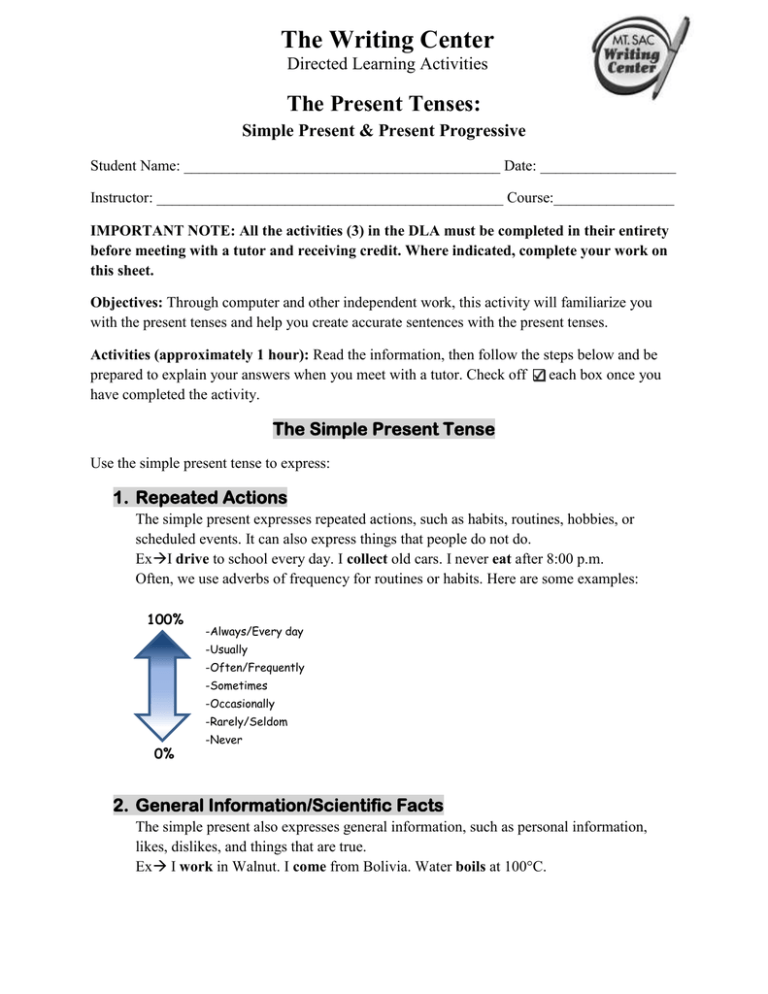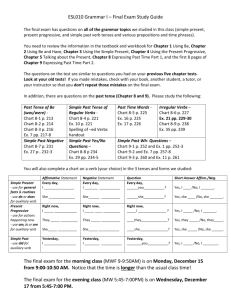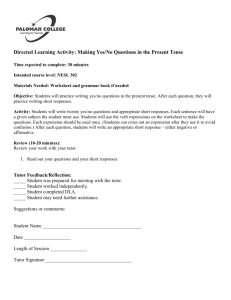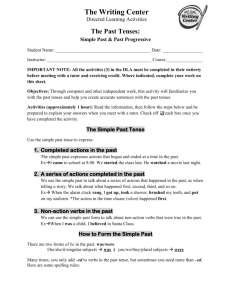The Writing Center The Present Tenses: Directed Learning Activities
advertisement

The Writing Center
Directed Learning Activities
The Present Tenses:
Simple Present & Present Progressive
Student Name: __________________________________________ Date: __________________
Instructor: ______________________________________________ Course:________________
IMPORTANT NOTE: All the activities (3) in the DLA must be completed in their entirety
before meeting with a tutor and receiving credit. Where indicated, complete your work on
this sheet.
Objectives: Through computer and other independent work, this activity will familiarize you
with the present tenses and help you create accurate sentences with the present tenses.
Activities (approximately 1 hour): Read the information, then follow the steps below and be
prepared to explain your answers when you meet with a tutor. Check off
each box once you
have completed the activity.
The Simple Present Tense
Use the simple present tense to express:
1. Repeated Actions
The simple present expresses repeated actions, such as habits, routines, hobbies, or
scheduled events. It can also express things that people do not do.
ExI drive to school every day. I collect old cars. I never eat after 8:00 p.m.
Often, we use adverbs of frequency for routines or habits. Here are some examples:
100%
-Always/Every day
-Usually
-Often/Frequently
-Sometimes
-Occasionally
-Rarely/Seldom
0%
-Never
2. General Information/Scientific Facts
The simple present also expresses general information, such as personal information,
likes, dislikes, and things that are true.
Ex I work in Walnut. I come from Bolivia. Water boils at 100°C.
DLA: Present Tenses 2
3. Non-Action Verbs
These verbs do not describe actions or things that you can perform. Rather, they indicate
states of being (mental, emotional, physical), sense, desire, possession, or opinion.
Ex I know you. He doesn’t like milk. We have a dog. You look tired. I am hungry.
How to Form the Simple Present
There are three forms of be: am/is/are
I am § he/she/it/singular subjects is § you/we/they/plural subjects are
We use the –s form when the subject
is he, she, it, or a singular noun:
We use the base form of the verb when
the subject is I, you, we, they or a plural noun:
I
You
We
They
My friends
He
She
It
The teacher
My brother
run.
runs.
Many times, you only add –s to verbs for he/she/it, but sometimes you need more than –s. Here
are some spelling rules for the –s form:
Rule
Base Form
-s Form
Add –s to most verbs to make the –s form
hope
eat
hopes
eats
When the base form ends in ss, sh, ch, or x, add –es
and pronounce an extra syllable
miss
wash
catch
mix
misses
washes
catches
mixes
When the base form ends in a consonant + y, change
the y to i and add –es
carry
worry
carries
worries
When the base form ends in a vowel + y, add –s but
do not change the y
pay
enjoy
pays
enjoys
Add –es to go and do
go
do
goes
does
The Present Progressive Tense
We use the present progressive tense to express:
1. Actions that are happening right now
The present progressive expresses on-going actions in the present.
ExYou are reading this page. The student is typing on the computer.
DLA: Present Tenses 3
2. Actions that are happening for a temporary time
The present progressive also expresses actions that are happening for a temporary time only.
Sometimes, they will use expressions like this week, this month, this semester, this year, etc.
ExI am taking English 67 this semester.
How to Form the Present Progressive
{ am/is/are + verb-ing }
Ex I am driving on the freeway. The teacher is talking to a student. We are taking this class.
*Non-action verbs (mental states, emotional states, possession, be, etc.) are usually not in a
progressive form.
How to Make Questions and Negative Statements
Negative statements: All verbs (except be; it never needs a helper) that have only one part to
them (one-word verbs) need the helper do or does and not to become negative. Start with the
subject , then be/do/does not, and then the base form of the verb. Verbs that have two or more
parts already have a helper, so you just add not between the helper and the main verb.
1
1
Ex I live in Brea.
I do not live in Brea.
1
1
2
He likes chocolate.
I am sad.
We are studying.
He doesn’t like chocolate.
I am not sad.
We aren’t studying.
Questions: All verbs (except be; it never needs a helper) that have only one part to them (oneword verbs) need the helper do or does. The helper is first, then the subject , and then the base
form of the verb. Verbs that have two or more parts already have a helper—the first part of the
verb is the helper. You can add a wh- word at the beginning if you need it.
1
Ex She lives in New York.
1
1
2
You are tired.
They are making a cake.
Does she live in New York?
Are you tired?
Are they making a cake?
Where does she live?
Why are you tired?
What are they making?
1. Review the information on this sheet. Then, answer the following questions.
In what situations do we use the simple present tense? ____________________________
_________________________________________________________________________
In what situations do we use the present progressive tense? _________________________
_________________________________________________________________________
DLA: Present Tenses 4
2. Reserve a computer in the lab. Click on the Launch FEG Interactive icon (a green square
with a white bird) on the desktop. Click “I do not wish to save my answers” and “Next.”
Then, click “Outline” and the plus (+) on 1 “Present Time.” Click and take the Test
(Questions 1-20) at the end of the unit. After you submit your test responses, PLEASE
ASK A LAB TUTOR TO PRINT THE PAGE THAT HAS YOUR SCORE. DO NOT
EXIT THE PROGRAM UNTIL THE TUTOR HAS PRINTED THIS PAGE (FREE OF
CHARGE).
3a. Collect some of your graded work. Find examples of sentences that contain the following:
1. Repeated Action:_________________________________________________________
_______________________________________________________________________.
2. General Information or Fact: _______________________________________________
_______________________________________________________________________.
3. Non-Action Verb: ________________________________________________________.
_______________________________________________________________________.
4. Action happening right now or for a temporary time: _____________________________
_______________________________________________________________________.
If you do not have your own essay to work with, please complete the supplemental
activity below (3b).
3b. Get the envelope that reads “The Present Tenses—Activity 3b Word Cards” in the DLA
file. In it, you will find word cards. Form the following statements or questions. You must
use a different subject and verb every time. Make a sentence using the word cards, write it
down below, and then form another sentence. You will do this four times.
1. A negative statement in the simple present tense: ________________________________
________________________________________________________________________
2. An affirmative statement in the present progressive tense: _________________________
_______________________________________________________________________
DLA: Present Tenses 5
3. A question in the simple present tense: ________________________________________
_______________________________________________________________________
4. A question in the present progressive tense: ____________________________________
_______________________________________________________________________
4. Review: Sign up to see a tutor on the “DLA Walk-in” list. During your session with a tutor,
explain your work to demonstrate your understanding of the present tenses. Refer to your own
graded writing (or the completed activity) and explain to the tutor strategies that you used to
create sentences with simple present and present progressive.
Student’s signature: ______________________________________________ Date: __________
Tutor’s signature: ________________________________________________ Date: _________
IMPORTANT NOTE: All the activities (3) in this DLA must be completed in their entirety
before meeting with a tutor and receiving credit. If your instructor wants evidence of this
completed DLA, return this form to him or her with the tutor’s signature included.





